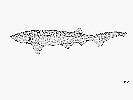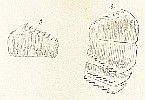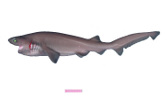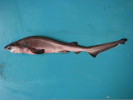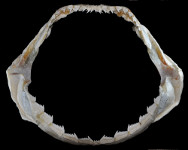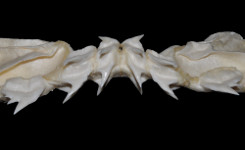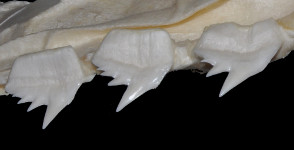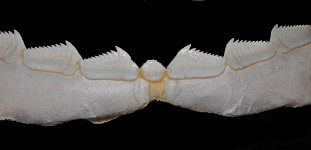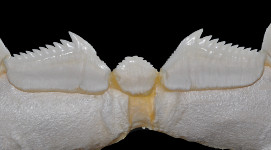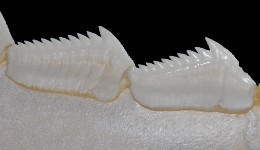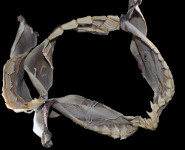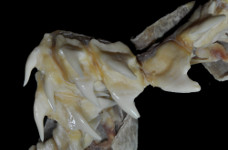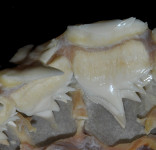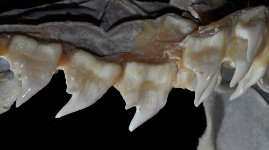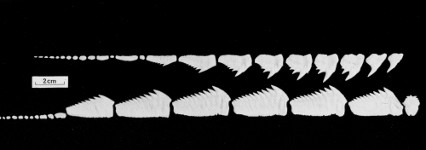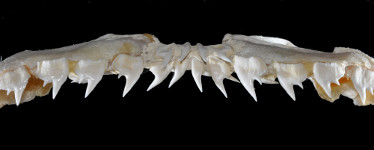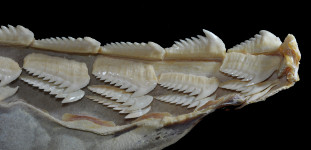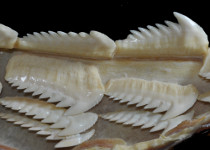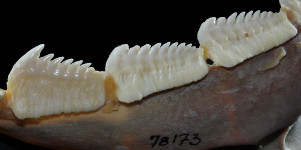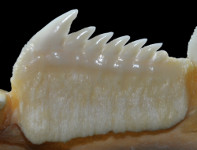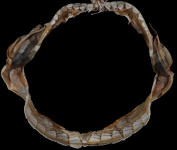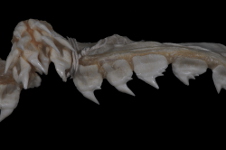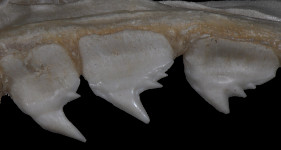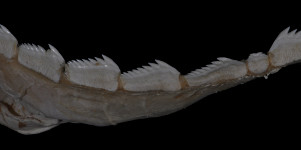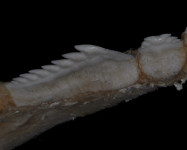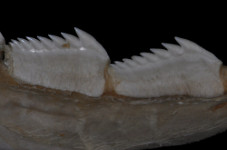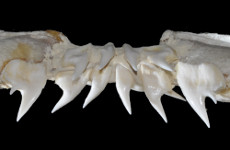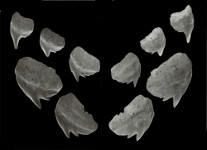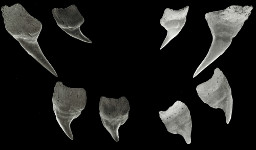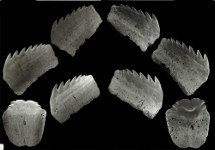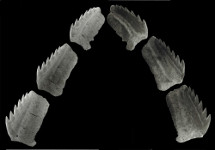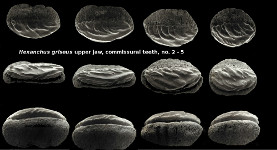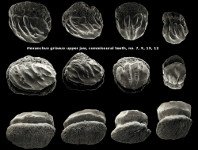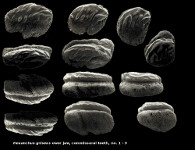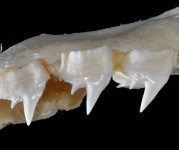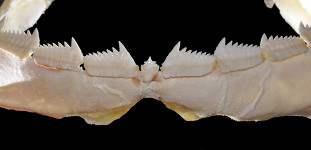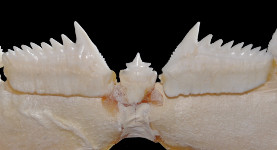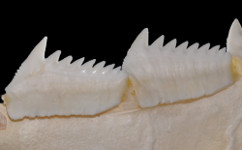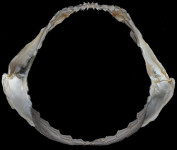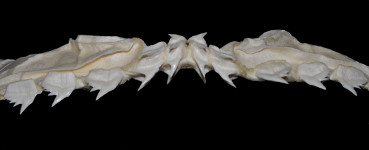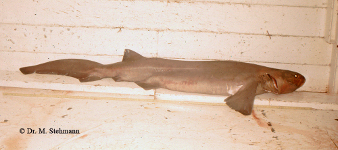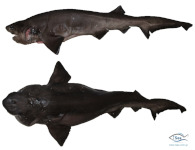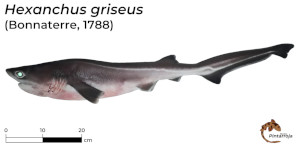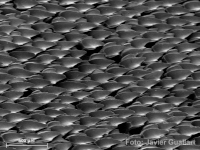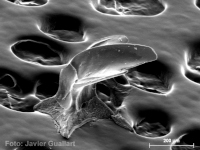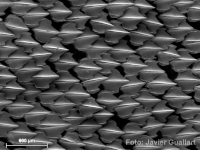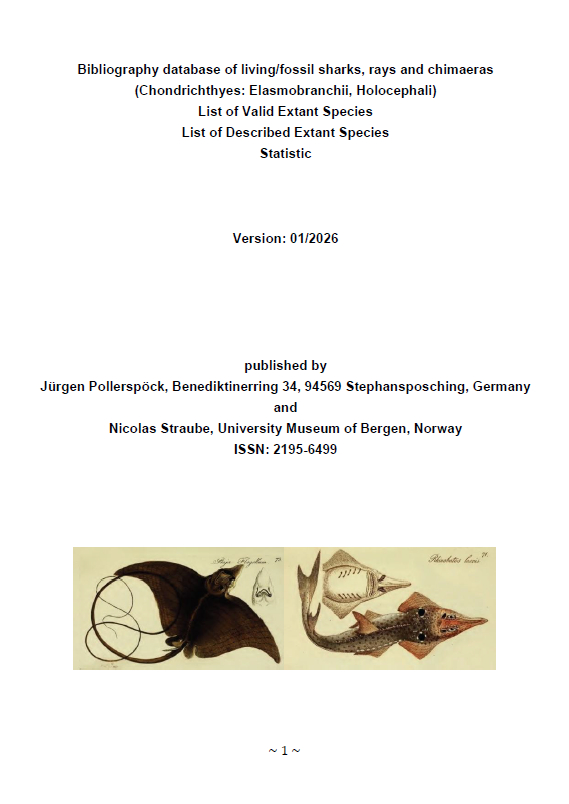Hexanchus griseus
(Bonnaterre, 1788)
Bluntnose sixgill shark
Classification: Elasmobranchii Hexanchiformes Hexanchidae
Reference of the original description
Ichthyologie. Tableau encyclopédique et méthodique des trois règnes de la nature. Paris, 215 p., pl. A–B + 1–100.
Ichthyologie. Tableau encyclopédique et méthodique des trois règnes de la nature. Paris, 215 p., pl. A–B + 1–100.
Image of the original description
No image in first description.
No image in first description.
Synonyms / new combinations and misspellings
Hexanchus aff. griseus, Hexanchus cf. griseus, Hexanchus corinum, Hexanchus corinus, Hexanchus griseus australis , Notidanus griseus, Notidanus vulgaris, Notidanus (Hexanchus) corinus, Notidanus (Hexanchus) griseus, Notorynchus griseus, Squalus griseus, Squalus vacca
Hexanchus aff. griseus, Hexanchus cf. griseus, Hexanchus corinum, Hexanchus corinus, Hexanchus griseus australis , Notidanus griseus, Notidanus vulgaris, Notidanus (Hexanchus) corinus, Notidanus (Hexanchus) griseus, Notorynchus griseus, Squalus griseus, Squalus vacca
Types
Hexanchus griseus
XXXX: No types known;
Hexanchus corinus
Holotype: USNM: 27369;
Hexanchus griseus australis
Holotype: EBMC: 10365
Squalus vacca
XXXX: No types known;
Hexanchus griseus
XXXX: No types known;
Hexanchus corinus
Holotype: USNM: 27369;
Hexanchus griseus australis
Holotype: EBMC: 10365
Squalus vacca
XXXX: No types known;
Description :
Citation: Hexanchus griseus (Bonnaterre, 1788): In: Database of modern sharks, rays and chimaeras, www.shark-references.com, World Wide Web electronic publication, Version 01/2026
Please send your images of "Hexanchus griseus" to info@shark-references.com
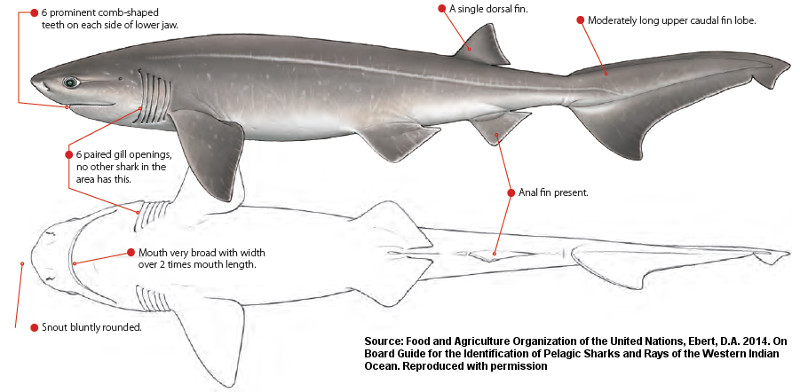
Hexanchus griseus (Bonnaterre, 1788), © FAO, Food and Agriculture Organization of the United Nations, Ebert, D.A. 2014. On Board Guide for the Identification of Pelagic Sharks and Rays of the Western Indian Ocean. Reproduced with permission, illustration by Marc Dando , Wildlife Illustrator

Hexanchus griseus (Bonnaterre, 1788), © FAO, Food and Agriculture Organization of the United Nations, Ebert, D.A. 2014. On Board Guide for the Identification of Pelagic Sharks and Rays of the Western Indian Ocean. Reproduced with permission, illustration by Marc Dando , Wildlife Illustrator
Common names
 Grauhai,
Grauhai,  Großer Grauhai,
Großer Grauhai,  Notidan,
Notidan,  Rotbraunhai,
Rotbraunhai,  Rotgrauhai,
Rotgrauhai,  Sechskiemer,
Sechskiemer,  Speckfisch,
Speckfisch,  Stierhai,
Stierhai,  Stumpfnasen-Sechskiemenhai,
Stumpfnasen-Sechskiemenhai,  Albafara,
Albafara,  Albajar,
Albajar,  Bastriuvaca,
Bastriuvaca,  Boca dolça,
Boca dolça,  Boquidulce,
Boquidulce,  Cañabota,
Cañabota,  Cañabota cañabota gris,
Cañabota cañabota gris,  Cañabota gris,
Cañabota gris,  Gato de mar,
Gato de mar,  Marfara,
Marfara,  Marrajo,
Marrajo,  Peix xovato,
Peix xovato,  Tiburón cañabota,
Tiburón cañabota,  Tiburón de seis agallas,
Tiburón de seis agallas,  Tiburón de seis branquias,
Tiburón de seis branquias,  Tiburón gris,
Tiburón gris,  Arbano,
Arbano,  Bouca douça,
Bouca douça,  Bouche douce,
Bouche douce,  Chien de mer,
Chien de mer,  Griset,
Griset,  Mounge gris,
Mounge gris,  Requin griset,
Requin griset,  Requin grisé,
Requin grisé,  Atlantic mud shark,
Atlantic mud shark,  Atlantic mudshark,
Atlantic mudshark,  Bluntnose sixgill shark,
Bluntnose sixgill shark,  Brown shark,
Brown shark,  Bull dog shark,
Bull dog shark,  Bull shark,
Bull shark,  Cow shark,
Cow shark,  Gray shark,
Gray shark,  Grey shark,
Grey shark,  Mud shark,
Mud shark,  Six-gill shark,
Six-gill shark,  Six-gilled shark,
Six-gilled shark,  Sixgill cow shark,
Sixgill cow shark,  Sixgill shark,
Sixgill shark,  Sixgilled shark,
Sixgilled shark,  Notidano grigio,
Notidano grigio,  Pesce manzo,
Pesce manzo,  Pesce mbove,
Pesce mbove,  Squalo capochiatto,
Squalo capochiatto,  Squalo capopiatto,
Squalo capopiatto,  Testa piatta,
Testa piatta,  Albafar,
Albafar,  Albafora,
Albafora,  Canhabota cinzenta,
Canhabota cinzenta,  Cação-bruxa,
Cação-bruxa,  Olho-verde,
Olho-verde,  Tubarao-albafar, Murruna b'sitt gargi (malta)
Tubarao-albafar, Murruna b'sitt gargi (malta)
 Grauhai,
Grauhai,  Großer Grauhai,
Großer Grauhai,  Notidan,
Notidan,  Rotbraunhai,
Rotbraunhai,  Rotgrauhai,
Rotgrauhai,  Sechskiemer,
Sechskiemer,  Speckfisch,
Speckfisch,  Stierhai,
Stierhai,  Stumpfnasen-Sechskiemenhai,
Stumpfnasen-Sechskiemenhai,  Albafara,
Albafara,  Albajar,
Albajar,  Bastriuvaca,
Bastriuvaca,  Boca dolça,
Boca dolça,  Boquidulce,
Boquidulce,  Cañabota,
Cañabota,  Cañabota cañabota gris,
Cañabota cañabota gris,  Cañabota gris,
Cañabota gris,  Gato de mar,
Gato de mar,  Marfara,
Marfara,  Marrajo,
Marrajo,  Peix xovato,
Peix xovato,  Tiburón cañabota,
Tiburón cañabota,  Tiburón de seis agallas,
Tiburón de seis agallas,  Tiburón de seis branquias,
Tiburón de seis branquias,  Tiburón gris,
Tiburón gris,  Arbano,
Arbano,  Bouca douça,
Bouca douça,  Bouche douce,
Bouche douce,  Chien de mer,
Chien de mer,  Griset,
Griset,  Mounge gris,
Mounge gris,  Requin griset,
Requin griset,  Requin grisé,
Requin grisé,  Atlantic mud shark,
Atlantic mud shark,  Atlantic mudshark,
Atlantic mudshark,  Bluntnose sixgill shark,
Bluntnose sixgill shark,  Brown shark,
Brown shark,  Bull dog shark,
Bull dog shark,  Bull shark,
Bull shark,  Cow shark,
Cow shark,  Gray shark,
Gray shark,  Grey shark,
Grey shark,  Mud shark,
Mud shark,  Six-gill shark,
Six-gill shark,  Six-gilled shark,
Six-gilled shark,  Sixgill cow shark,
Sixgill cow shark,  Sixgill shark,
Sixgill shark,  Sixgilled shark,
Sixgilled shark,  Notidano grigio,
Notidano grigio,  Pesce manzo,
Pesce manzo,  Pesce mbove,
Pesce mbove,  Squalo capochiatto,
Squalo capochiatto,  Squalo capopiatto,
Squalo capopiatto,  Testa piatta,
Testa piatta,  Albafar,
Albafar,  Albafora,
Albafora,  Canhabota cinzenta,
Canhabota cinzenta,  Cação-bruxa,
Cação-bruxa,  Olho-verde,
Olho-verde,  Tubarao-albafar, Murruna b'sitt gargi (malta)
Tubarao-albafar, Murruna b'sitt gargi (malta)
Short Description
A heavily-bodied, broad-headed sixgill shark, mouth ventral with 6 rows of lower, bladelike, comb-shaped teeth on each side [518]. Snout broadly rounded, body fusiform [1388]. Anal fin smaller than dorsal fin [1388]. Brown or grey above, paler below, with a light stripe along side [578]. Fins with white edges [20040]. Live specimens with fluorescent green eyes [1388]. Six gill slits are very long [20241].
A heavily-bodied, broad-headed sixgill shark, mouth ventral with 6 rows of lower, bladelike, comb-shaped teeth on each side [518]. Snout broadly rounded, body fusiform [1388]. Anal fin smaller than dorsal fin [1388]. Brown or grey above, paler below, with a light stripe along side [578]. Fins with white edges [20040]. Live specimens with fluorescent green eyes [1388]. Six gill slits are very long [20241].
Distribution
Circumglobal: In tropical and temperate waters; [544]. Western Atlantic: North Carolina to Florida (USA) and northern Gulf of Mexico to northern Argentina. Eastern Atlantic: Iceland and Norway to Namibia, including the Mediterranean. Indian Ocean: Madagascar, Mozambique, and South Africa. Western Pacific: eastern Japan to New Zealand and Hawaii. Eastern Pacific: Aleutian Islands, Alaska to Baja California, Mexico; also Chile . Highly migratory species, Annex I of the 1982 Convention on the Law of the Sea [20076] (Ref. 41819).
First records: 2014: southern Coastal Waters of Oman in the Arabian Sea [20606]; Source: www.gbif.org
Circumglobal: In tropical and temperate waters; [544]. Western Atlantic: North Carolina to Florida (USA) and northern Gulf of Mexico to northern Argentina. Eastern Atlantic: Iceland and Norway to Namibia, including the Mediterranean. Indian Ocean: Madagascar, Mozambique, and South Africa. Western Pacific: eastern Japan to New Zealand and Hawaii. Eastern Pacific: Aleutian Islands, Alaska to Baja California, Mexico; also Chile . Highly migratory species, Annex I of the 1982 Convention on the Law of the Sea [20076] (Ref. 41819).
First records: 2014: southern Coastal Waters of Oman in the Arabian Sea [20606]; Source: www.gbif.org
Human uses
fisheries: commercial; gamefish: yes
fisheries: commercial; gamefish: yes
Biology
Ovoviviparous, litters very large, 22 to 108 [518]. Size at birth 60-75 cm [578]. Distinct pairing with embrace [17086]. Depth range reported at 0m-2000m. A deepwater species of the outer continental and insular shelves and upper slopes [1388] (Ref. 75154). Near bottom, occasionally pelagic, adults usually below 91 m [17640]. Juveniles may be found close inshore [1388]. Found on the bottom by day, moving to the surface at night to feed, and where it may take longlines set for other species [432]. Depth distribution related to growth and temperature, with juveniles having most shallow records and from colder, poleward regions [17640]. Feeds on a wide range of marine organisms, including other sharks, rays, chimaeras, bony fish, squids, crabs, shrimps, carrion, and even seals. Is a eurytrophic predator that is capable of exploiting a wide range of prey species and habitats [754]. A vertical migrant, it may sit on the bottom by day, and rise to the surface at night to feed [518].
Ovoviviparous, litters very large, 22 to 108 [518]. Size at birth 60-75 cm [578]. Distinct pairing with embrace [17086]. Depth range reported at 0m-2000m. A deepwater species of the outer continental and insular shelves and upper slopes [1388] (Ref. 75154). Near bottom, occasionally pelagic, adults usually below 91 m [17640]. Juveniles may be found close inshore [1388]. Found on the bottom by day, moving to the surface at night to feed, and where it may take longlines set for other species [432]. Depth distribution related to growth and temperature, with juveniles having most shallow records and from colder, poleward regions [17640]. Feeds on a wide range of marine organisms, including other sharks, rays, chimaeras, bony fish, squids, crabs, shrimps, carrion, and even seals. Is a eurytrophic predator that is capable of exploiting a wide range of prey species and habitats [754]. A vertical migrant, it may sit on the bottom by day, and rise to the surface at night to feed [518].
Size / Weight / Age
TL (max): female: 482 cm TL [33022]); max. published weight: 590.0 kg [20202], born at 65-70 cm [3365]
TL (max): female: 482 cm TL [33022]); max. published weight: 590.0 kg [20202], born at 65-70 cm [3365]
Habitat
bathydemersal; oceanodromous [17660]; marine; depth range 1 - 2500 m [17640], usually 180 - 1100 m [432]
bathydemersal; oceanodromous [17660]; marine; depth range 1 - 2500 m [17640], usually 180 - 1100 m [432]
Remarks
shark-references Species-ID=2855;
shark-references Species-ID=2855;
Parasites (arranged by Jürgen Pollerspöck)
Myxosporea
Monogenea
Cestoda
Trematoda
Nematoda
Acanthocephala
Copepoda
Isopoda
Myxosporea
- Chloromyxum bulliti Lisnerova, Martinek, Alama-Bermejo, Bouberlova, Schaeffner, Nkabi, Holzer & Bartosova-Sojkova, 2022 [31228]
Monogenea
- Erpocotyle grisea (Cerfontaine, 1899) [31477]
- Protocotyle grisea (Cerfontaine, 1899) Euzet & Maillard, 1974 [22589] [17150] [14443] [24914] [34006]
- Protocotyle taschenbergi (Maillard & Oliver, 1966) [31478] [31477] [22559] [14443]
Cestoda
- Acanthobothrium filicolle (Zschokke, 1887) [16448]
- Acanthobothrium paulum Linton, 1890 [16448]
- Anthocephalum centrurum (Southwell, 1925) [16443]
- Anthocephalum gracile (Wedl, 1855) [16443]
- Carrassoniella sinuosiceps (Williams, 1959) [10854] [16443] [16182] [9358] [25154] [32102] [34609]
- Crossobothrium campanulatum Klaptocz, 1906 [19899]
- Crossobothrium dohrnii (Oerley, 1885) Ruhnke, 1996 [11700] [16383] [16443] [16182] [16200] [9358] [25154]
- Crossobothrium laciniatum Linton, 1889 [25154]
- Grillotia acanthoscolex Rees, 1944 [16303] [16112] [32810]
- Grillotia heptanchi (Vaullegeard, 1899) [17843] [16182] [16112] [25154]
- Grillotia institata (Pintner, 1931) [16112]
- Grillotia megabothria (Hart, 1936) [16112]
- Grillotia smaris-gora (Wagener, 1854) [16112]
- Hepatoxylon megacephalum (Rudolphi, 1819) [16112]
- Hepatoxylon trichiuri (Holten, 1802) [21481] [16112]
- Nybelinia lingualis (Cuvier, 1817) [16112]
- Nybelinia sp. [32102]
- Nybelinia surmenicola Okada in Dollfus, 1929 [16112]
- Phyllobothrium lactuca Van Beneden, 1850 [16443]
- Phyllobothrium rotundum (Klaptocz, 1906) [19899] [16443]
- Scyphophyllidium triacis (Yamaguti, 1952) [16443]
- Tetrarhynchus sp. [17919]
Trematoda
Nematoda
Acanthocephala
Copepoda
- Achtheinus oblongus Wilson, 1908 [7660] [15303] [27172]
- Demoleus heptapus (Otto, 1821) [14785] [16609] [16609] [27114] [26739] [31646] [31532]
- Lepeophtheirus salmonis (Krøyer, 1837) [8059]
- Nemesis robusta (Van Beneden, 1851) [16609]
- Pandarus bicolor Leach, 1816 [753]
- Protodactylina pamelae Laubier, Maillard & Oliver, 1966 [31478] [16609]
Isopoda
- Aega bicarinata Leach, 1818 [23898]








